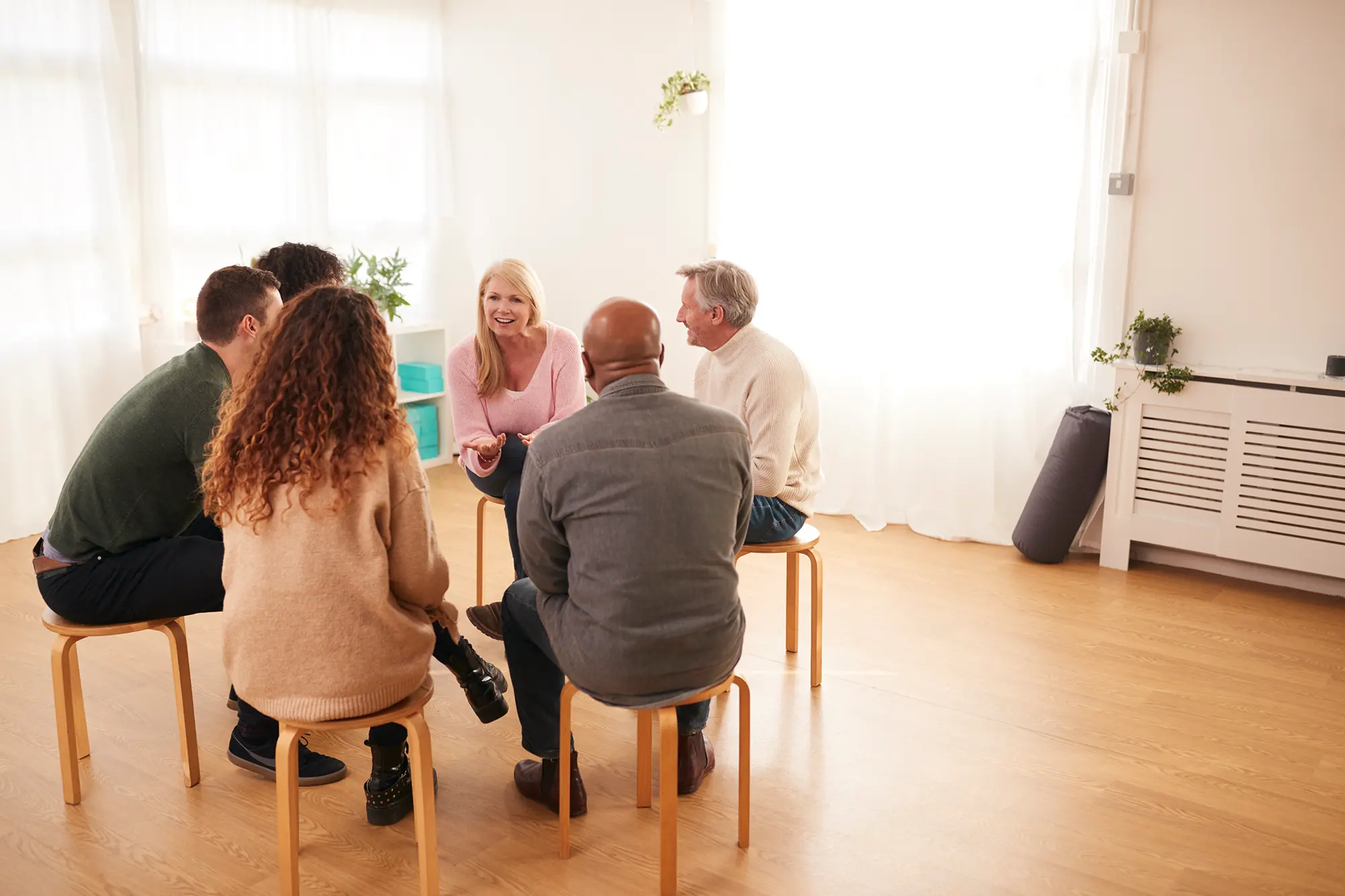Expecting Positive Change
May 30, 2020
This month I have invited Hannah Smith, MA LMHC CGP, Group Therapy Training & Curriculum Consultant for The Center, to write a guest blog for my website. This is the sixth in a six-part series on Relationship Communication. To see the other blogs in this series, visit The Center • A Place of HOPE Blog. Thanks Hannah!
Every year, many struggling couples try counseling. They attend sessions and put forth a valiant effort to learn and use new skills. However, they often deem their hard work ineffective when they fail to see the expected positive change. Certainly, there are various reasons for this, but it may surprise you to know that one of the main culprits in this situation is your very own brain!
“What does the brain have to do with couple’s counseling?” you ask? Great question! To illustrate, consider Treya and Ricardo.
The door opened and a kindly, slightly gray-haired woman with a messy bun and glasses hanging around her neck peered out and called their names. She was clad in sandals and flowing, flowery skirt and mauve-colored tunic. As they followed the woman down the hall, Treya noticed the hand-woven ankle bracelets and smiled. Maybe this won’t be so bad after all.
Once ushered into a scantily furnished, earth-toned room and sat on a plush, grey couch, they were all formally introduced. The counselor, Dr. Henderson, gave her name, credentials, and a brief soliloquy on how couple’s counseling usually works. Treya and Ricardo were then asked loads of questions about themselves. That first hour felt like a month and neither of them were sure they would make it through.
But they did.
They continued the sessions, learning the DECIDE acronym. Everything made sense and theoretically, they both felt their new skills would work – and they did, at first. Over time, though, no matter how great their practice was, the air between them still ended up feeling tense and impenetrable. Close to giving up, they were encouraged and agreed to attend one more session.
Dr. Henderson took fifteen minutes alone with each of them and then brought them back together and asked a question neither of them had expected. “Treya, did you know that when Ricardo does certain behaviors, you squint your eyes and furrow your brow?”
Treya was dumbfounded. “No, I had no idea. What difference does that make?”
Can you answer Treya’s question? What difference does her face make, after all? As it turns out, all the difference in the world!
Believe it or not, most of what gets you through the day comes from non-conscious areas of your brain. Think about the last time you went to the kitchen or poured yourself a cup of coffee or a cold drink. At any point, did you hear your brain say, “Stand up legs, left foot go, right foot go,” or “Pick up drink, bend arm at ninety-degree angle, pour into mouth”? No, of course not. Even so, all of that is orchestrated in your brain.
When we meet people or interact with our environment, automatic processes in our brains are busy at work tagging things as “safe” or “unsafe” and “efficient” or “inefficient” (this is oversimplified, but it works for our purposes). This is because safety and efficiency are major brain goals, neither of which could ever happen if we had to think consciously about everything we do.
Treya fell in love with exotic Ricardo and thought herself the luckiest girl alive when he asked her to marry him. Thinking things could not be better, the birth of their first child proved her wrong. Life was grand and all was right with the world…until it wasn’t. No matter how hard we try, we will make mistakes and disappoint each other. If we are not mindful, our brains can throw the actions of others in the “bad box” in order to be safe and efficient. One of the most common ways this happens is with non-verbal cues.
The first few times someone disappoints us, it is a surprise. At first, when Ricardo forgets to call when he is going to be late, Treya recognizes it as an act that is out of character for him. Being novel, Treya forgives him and is able to move on without too much trouble. Over time, however, the novelty wears off and Treya’s brain cannot reconcile the behavior with who she thinks Ricardo is and boom! Into the bad box he goes.
Once this happens, filters in Treya’s brain cause her to pay particular attention to offenses and before she knows it, Ricardo becomes the enemy. After a while, whenever he came in the door late, she made “that face” at him. After a few weeks in counseling, Ricardo learned to call ahead and tell her he would be late. This made Treya much happier, but even so, every time he walks in the door, he sees the same expression and he feels all is lost.
The dynamic in play here is known as a trigger response. A trigger is created when a particularly strong stimulus is paired with an equally strong emotional response. Triggers can be happy and bright, but the ones we are concerned with elicit fear, anger, sadness, or some other unpleasant emotion. People often do not know or forget the cause of the trigger as they are created in the part of the brain that works on association and not detail. The alarm system of the brain, known as the amygdala, works in cahoots with something called the hippocampus, which is responsible for memory storage. In a trigger situation, such as Ricardo being late, the amygdala tags a memory with emotion. Because of the associative and undetailed nature of the pairing, the triggers are not always logical.
The moral of this story is: You must remind your brain to look for positive change. This brings us to our final letter in DECIDE, namely E – Expect positive change. Here are a few ideas to help you do this.
Pay Attention to Your Triggers. Let me just say from the get-go, you will never learn all your triggers. In fact, you will tell yourself stories about possible triggers that are outright incorrect. That is okay. You can treat a trigger response without knowing what the trigger is. However, the more of them you know, the more able you will be to respond in a helpful manner when they occur. A few ideas for recognizing triggers is to pay attention to your “go to” unpleasant emotion. Suppose you lean into sadness. Every time you notice yourself feeling sad, you might ask yourself, “What just happened?” For Ricardo, the answer was, “I came in the door after work. I was on time, but I used to be late and now my coming in the door after work is a trigger.” It can take some work to unearth triggers but being mindful of what just happened can help.
Notice Differences. When you have been actively working on an issue with someone and you hear your brain say, “Nothing has changed,” consider taking a moment to stop and spend some time looking for proof to the contrary. Treya would benefit from noticing consciously that Ricardo is on time and telling her fact to give him a smile. Ricardo would feel better if he noticed that Treya had begun to hug him and ask about his day, even though she had also made “that face.”
Cultivate Gratitude as a Way of Exercising Your Brain. In high-stress situations, the brain shuts down a lot of its resources and focuses on the task at hand. When we “flip our lids” – which is often our response to a trigger, we lose connection to the flexible part of our brain and become rather rigid. Ultimately, problems arise when the binary brain is left in charge. Creating a flexible stance amid difficulty takes work, practice, and a svelte brain! You can exercise this ability by keeping the window of possibilities open. Gratitude is a practice that you can do daily to keep your brain flexible. This works by forcing the strained and anxious brain to see assets as well as deficits. Try writing down three things you are grateful for every day – and if you cannot think of three, then create a list of activities and experiences you can add to any given day that create a sense of gratitude. After all, your happiness is your job – don’t wait for it to “just happen.”
Communication with our loved ones is a rocky journey – but it is a worthy endeavor offering rewards not found anywhere else on earth! If you are at a dead end or a fork in the road with someone you love and cannot seem to find your way out, consider calling The Center for help. The caring staff will teach and model healthy interaction skills and support you as you and yours build a close and abundant life as you DECIDE to put your best foot forward into a happier, healthier future!
Written by Hannah Smith, MA LMHC CGP, Group Therapy Training & Curriculum Consultant for The Center ● A Place of HOPE. As a Neuroscience-informed, Licensed Therapist and International Board-certified Group Psychotherapist, Hannah’s passion is to see people reach their potential and find lasting, positive change.
The Center • A Place of HOPE is recognized as a Top Ten Center For Depression Treatment in the United States. Founder by Dr. Gregory Jantz over 30 years ago, it has helped thousands regain their strength and happiness through its whole person approach to care. If you are struggling with depression, anxiety, trauma, PTSD, addiction, eating disorders, or other mental health challenges, call The Center at 888.771.5166 today.
OTHER POPULAR ARTICLES

Alternative Approaches to Treatment-Resistant Depression: Holistic Strategies When Traditional Methods Fall Short
When standard treatments for depression fail to provide relief, the journey toward healing can feel overwhelming and discouraging. Treatment-resistant depression (TRD) affects approximately 30%...

Cognitive Behavioral Therapy vs. Medication: A Holistic Perspective on Anxiety Treatment
When facing anxiety, choosing the right treatment approach is one of your most important decisions. The debate between Cognitive Behavioral Therapy (CBT) and medication...

Dialectical Behavior Therapy Techniques for Depression: Finding Balance and Healing
Depression can feel like being trapped in a dark room with no doors or windows, a place where hope seems distant and joy feels...